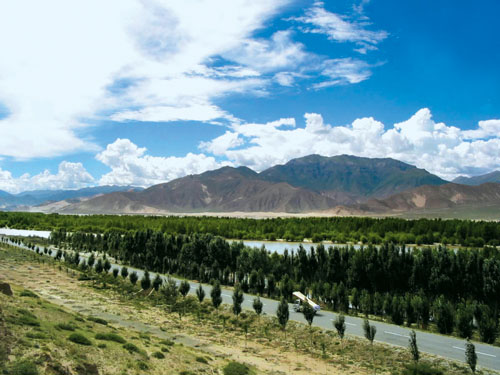|
 Large expanse of forested area by the Yarlung Zangbo River.
Large expanse of forested area by the Yarlung Zangbo River.
Tibet serves as the ecological safety barrier to China and even Asia, with a unique ecological zone. Strengthening ecological environment protection and construction, building the State ecological safety barrier on the Tibet Plateau, maintaining ecological functions, guaranteeing ecological safety and constructing an ecological Tibet have been the important content of steady ecological development.
In recent years, Tibet has set up a leading group for the Plan for the State Ecology Safety Barrier Protection and Construction on the Tibetan Plateau and invited academicians and experts from the Chinese Academy of Science, State Commission of Natural Science Foundation and the China Meteorological Administration for on-the-spot investigation and to work out the Plan for the State Ecology Safety Barrier Protection and Construction on the Tibetan Plateau (in short "Ecological Plan"). The plan, with estimated investment totaling 38.7 billion Yuan, was launched in 2007. The construction and implementation of the plan will effectively check the degenerating trend of ecological systems around the headwaters of rivers and the key lakes in Tibet, maintain ecological functions on the Tibet Plateau such as water source conservation, biodiversity protection and the conservation of soil and water, enhance the capability for sustainable development of the regional economy and ensure the regional ecological safety and the nation's safety.
In order to realize this goal, Tibet will lay stress strengthening the supervision and management of the ecological environment in developing important natural resources and tourist resources. Under the precondition of giving priority to protecting the ecological environment, it is actively exploring water and electricity resources in an orderly way, and developing renewable energy resources such as the solar energy and geothermal energy and new energy resources such as biomass energy according to local conditions. It is standardizing the order of mineral resources development, adhering to the principle of "placing equal stress on protection and development" and promoting sustainable use of resources through protection. In conducting urban planning and construction, attention should be paid to the natural and ecological conditions, and the natural heritage, such as natural forest and grassland, rivers and lakes, shallows-tidal flat areas, wetlands, natural physiognomy and wild animals and plants, should be conserved as much as possible. These will all promote the improvement of Tibet's ecological environment in an all-round way, providing a good ecological basis for its economic and social development.
According to Zhang Yongze, Director of the regional department of environmental protection, the State has always attached great importance to ecological conservation in the plateau region and will put hefty investment into the construction of the State ecological safety barrier project on the Tibet Plateau. The Central Government plans to spend more than 10 billion Yuan to implement the Ecological Plan during the 2006-2030 period. Fourteen conservation projects divided into three categories will be launched, covering natural grassland and wildlife protection, artificial grass, the control of desertification and soil erosion, mine reforestation and geological disasters prevention, and ecological monitoring and supervision. The goal is to reconvert some 14.96 million hectares of pasture into grassland, and restore grassland of 4.2 million hectares, enabling 77 percent of medium or above degenerated grasslands to be effectively protected and controlled; to protect native vegetation on 8.34 million hectares of forest, and restore degenerated forest and construct a shelter-forest belt on 4.368 million hectares of land, making the protected and constructed forest land account for 78 percent of the total; to reverse desertification and soil erosion on 306,000 hectares and 3.15 million hectares respectively. In addition, during the "11th Five-Plan", the Central Government put about 120 million Yuan into protecting the Lhalu wetland in Lhasa - the highest and biggest urban wetland in the world - the nature reserve of sacred Namco Lake and grasslands in Nagqu prefecture. The Central Government and the regional government have allocated 26.77 million Yuan and 11.72 million Yuan respectively to be used to strengthen the construction of Tibetan infrastructure for environmental protection in all-around way and raise Tibetan capacity to conduct environmental protection.
(China's Tibet Facts and Figures 2008) |
